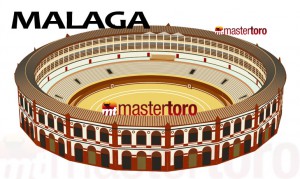Bullrings
 Madrid bullring
Madrid bullring
A bullring is the stadium where bullfighting takes place: the arena. Bullrings are often associated with Spain, but they can also be found in other american and european counties as Portugal, France, Mexico, Venezuela, Peru and others. Actually, the biggest bullring is in Mexico, called the Monumental de Mexico.
Bullrings have many structural similarities to the Roman amphitheatre, as can be seen in the following pictures.
The classic bullring is an enclosed, roughly circular amphitheatre with a large number of rows that surround the arena. The open space forms the “ruedo”, a field of densely packed crushed rock (albero). Also on the ground level, the central arena is surrounded by a staging area where the bullfighters prepare and take refuge, called the callejón (alley). The callejón is separated from the arena by a wall or other structure, usually made of wood and roughly 140 cm high. The partition wall has doors for the entrance and exit of the bull (puerta de los toriles) and human participants (puerta de cuadrilla), although the form, number, and placement of these doors will vary from one bullring to another. In regular places, the wall is pushed outwards leaving splits (burladero, from burlar: to evade, to dodge) that allow the bullfighters to go in the arena and to take refuge but are too narrow for the bull. Nevertheless, on rare occasions the bull jumps the wall causing havoc in the corridor.
 The walls also have a type of stirrup or foothold that aids in crossing over to the central arena, and sometimes stirrups on the arena side as well; these are used mostly by event staff if they need to intervene quickly in the case of an emergency. The arena is surrounded by climbing rows of seats. The seats are priced differently according to the position of the sun during the show, normally in the afternoon. The hot sol, “sun”, is cheaper than the fresher sombra, “shade”.
The walls also have a type of stirrup or foothold that aids in crossing over to the central arena, and sometimes stirrups on the arena side as well; these are used mostly by event staff if they need to intervene quickly in the case of an emergency. The arena is surrounded by climbing rows of seats. The seats are priced differently according to the position of the sun during the show, normally in the afternoon. The hot sol, “sun”, is cheaper than the fresher sombra, “shade”.
Bullrings evolved as specialized sporting arenas hand-in-hand with the sport that demanded them. Many of the ancient Roman amphitheatres had characteristics that can be seen in the bullrings of today (in fact the ring in Nîmes, France, is a Roman artifact, though it is more elliptical than the usual plaza), and the origin of bullfighting is very closely related to certain Roman traditions. In the formative years of the sport on the Iberian peninsula, those Roman enclosures were not commonly utilised for bullfighting events. Back when bullfighting festivals were conducted principally on horseback, the spectacle was a more public affair that took place in the city’s open plaza area. It was only later, when bullfights were conducted principally by men on foot, that the public needed a structure to house them appropriately. Not only did the crowd need special seating to view the spectacle, they also needed a structure to contain the general disorder that reigned at festivals during the heyday of such legendary figures as Costillares, Pedro Romero and Pepe-Hillo. In these early days, the circular form was not to be taken for granted.
 Sevilla bullring La Maestranza
Sevilla bullring La Maestranza
When La Maestranza bullring in Sevilla was authorized for construction in 1730 specifically to house bullfights, the original plans called for a rectangular arena for the first three years, only later to be changed to a circular form that avoided the cornering of the action and put all viewers at the same approximate distance, the same reason for the elliptical form of amphitheatres.
Another circular plaza was begun in Ronda in 1754, and it featured its first bullfights in 1782. In the change from the 19th to the 20th century, the Neo Mudéjar style became in vogue for plazas, involving decoration in visible brickwork. Since the 1990s, new construction technology allows some rings to be covered permanently or temporarily.
 Malaga bullring
Malaga bullring
